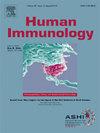一个作用和多个结果:基于反向疫苗学和免疫信息学方法的甲型流感病毒和SARS-CoV-2多表位杂交疫苗的探索
IF 2.2
4区 医学
Q3 IMMUNOLOGY
引用次数: 0
摘要
甲型流感病毒(IAV)和严重急性呼吸综合征冠状病毒2 (SARS-CoV-2)合并感染已被证明会加重症状,因此可被视为对易感人群的重大威胁。尽管疫苗接种是一种有效和安全的病毒预防策略,但这两种病毒的大量突变仍然是疫苗设计的一个问题,因为尽管引入了各种疫苗来预防病毒,但IAV和SARS-CoV-2的一些毒株仍然在世界范围内存在。方法采用生物信息学方法设计基于IAV和SARS-CoV-2抗原表位的杂交疫苗,该疫苗具有潜在的抗突变保守性,在毒性和过敏原性方面是安全的,但有望诱导持久的先天和适应性免疫反应。结果所选多肽显示出潜在的有效免疫应答,显示出安全、适用于杂交疫苗设计的前景。我们选择表位的重点是它们与细胞毒性T淋巴细胞(CTL)、辅助性T淋巴细胞(HTL)和B细胞的结合质量。例如,利用基于序列的预测方法检测CTL的表位,并确定其熵和抗原性。同样,所有表位的选择都是基于它们分别诱导强大的体液免疫和细胞介导免疫的能力。利用我们的方法设计杂交疫苗,可以产生下一代杂交疫苗,帮助医疗保健系统为易感人群建立更一致的防御两种病毒的防御。本文章由计算机程序翻译,如有差异,请以英文原文为准。
One Action and Multiple Results: Influenza A Virus and SARS-CoV-2 Poly-Epitope-Based Hybrid Vaccine Exploration by Reverse Vaccinology and Immunoinformatic Methods
Introduction
Influenza A virus (IAV) and severe acute respiratory syndrome coronavirus 2 (SARS-CoV-2) coinfection have been shown to intensify symptoms and, therefore, could be considered a significant threat to susceptible populations. Although vaccination is an effective and safe strategy to be used against viruses, large amounts of mutations in these two viruses remain an issue for vaccine design, as some strains of the IAV and SARS-CoV-2 are still present worldwide, regardless of the introduction of various vaccines to protect against the viruses.
Methods
We employed a bioinformatic approach to design a hybrid vaccine based on the epitopes of IAV and SARS-CoV-2, which are potentially conserved against mutations and are safe in terms of toxicity and allergenicity, yet promise to induce long-lasting innate and adaptive immune responses.
Results
The selected peptides demonstrated a potentially effective immune response and showed promise as safe and suitable for hybrid vaccine design. We selected epitopes focusing on their binding quality to cytotoxic T lymphocyte (CTL), helper T lymphocyte (HTL), and B cell. For instance, CTL′s epitopes were checked using sequence-based prediction methods, and their entropy and antigenicity were confirmed. Similarly, all epitopes were selected based on their ability to induce robust humoral and cell-mediated immunity, respectively.
Conclusion
Hybrid vaccine design, utilizing our approach, can lead to next-generation hybrid vaccines that help the healthcare system establish a more consistent defense against both viruses for the susceptible population.
求助全文
通过发布文献求助,成功后即可免费获取论文全文。
去求助
来源期刊

Human Immunology
医学-免疫学
CiteScore
5.40
自引率
7.40%
发文量
107
审稿时长
12 days
期刊介绍:
The journal''s scope includes understanding the genetic and functional mechanisms that distinguish human individuals in their immune responses to allografts, pregnancy, infections or vaccines as well as the immune responses that lead to autoimmunity, allergy or drug hypersensitivity. It also includes examining the distribution of the genes controlling these responses in populations.
Research areas include:
Studies of the genetics, genomics, polymorphism, evolution, and population distribution of immune-related genes
Studies of the expression, structure and function of the products of immune-related genes
Immunogenetics of susceptibility to infectious and autoimmune disease, and allergy
The role of the immune-related genes in hematopoietic stem cell, solid organ, and vascularized composite allograft transplant
Histocompatibility studies including alloantibodies, epitope definition, and T cell alloreactivity
Studies of immunologic tolerance and pregnancy
T cell, B cell, NK and regulatory cell functions, particularly related to subjects within the journal''s scope
Pharmacogenomics and vaccine development in the context of immune-related genes
Human Immunology considers immune-related genes to include those encoding classical and non-classical HLA, KIR, MIC, minor histocompatibility antigens (mHAg), immunoglobulins, TCR, BCR, proteins involved in antigen processing and presentation, complement, Fc receptors, chemokines and cytokines. Other immune-related genes may be considered.
Human Immunology is also interested in bioinformatics of immune-related genes and organizational topics impacting laboratory processes, organ allocation, clinical strategies, and registries related to autoimmunity and transplantation.
 求助内容:
求助内容: 应助结果提醒方式:
应助结果提醒方式:


